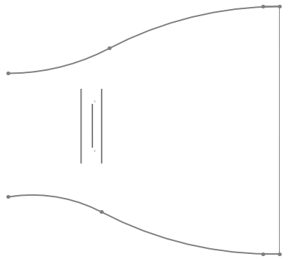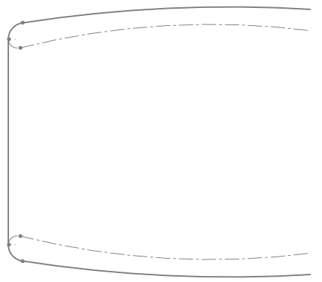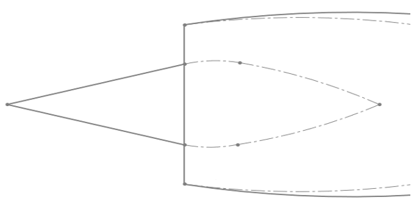This set of Basic Aircraft Design Questions and Answers focuses on “Propulsion – Jet-Engine Integration-2”.
1. What is the use of inlet section?
a) Slow down the incoming air
b) Increase the mach number of incoming air
c) Increase lift by wing
d) Increase lift curve slope of tail
View Answer
Explanation: One of the primary function of emulate is to reduce velocity of incoming air. Lift produced by wings can be increased with the help of high lift device such as flaps. Lift curve slope can be altered by using different angle of attacks.
2. Inlet pressure recovery is defined as ______
a) total pressure deliver to the engine divided by freestream total pressure
b) total dynamic pressure
c) incoming velocity by incoming Mach number
d) lift to drag ratio
View Answer
Explanation: Inlet pressure recovery is nothing but the total pressure which is deliver to the engine divided by the free stream total pressure. Dynamic pressure is exerted due to velocity of the fluid. Lift drag ratio is more important for the aerodynamics of the aircraft.
3. Which of the following is a type of inlet?
a) NACA flush inlet
b) Flap
c) Slat
d) Fuselage
View Answer
Explanation: Inlet has primary function to reduce flow velocity of the incoming air. NACA flush inlet is one of the example of typical inlet profile. Flap and slat are secondary control surfaces. Gisele is main body of an aircraft.
4. Following diagram represents ______

a) NACA flush inlet
b) Helical inlet
c) Flash inlet
d) Pitot tube cavity
View Answer
Explanation: A typical NACA flush inlet is shown in the above diagram. NACA flush inlet was used by several early jets but in modern days it is rarely used. NACA flush inlet can be used to reduce wetted area.
5. Following diagram represents _____

a) Pitot inlet
b) Flush inlet
c) NACA flush inlet
d) Bell inlet
View Answer
Explanation: The typical schematic diagram of pitot inlet is shown in above figure. A Pitot inlet is nothing but a simple forward facing hole. This inlet works well at typical low supersonic speed regimes.
6. Following diagram represents ______

a) Conical inlet
b) Spiral inlet
c) NACA flush mount
d) Pitot inlet
View Answer
Explanation: The above diagram is showing a typical conic or conical inlet geometry. Conical inlet is also known as spike inlet or round inlet. This type of inlets are used to operate in supersonic speeds. The spike inlet is typically lighter but can experience higher cowl drag.
7. Following diagram represents ______

a) 2D ramp inlet
b) Conical inlet
c) Pitot inlet
d) Flush inlet
View Answer
Explanation: A typical schematic diagram of 2d ramp is shown in above figure. 2d ramp inlet is used for supersonic speed regimes. It uses flow over wedge concept. Conical Inlet is also termed as round inlet. NACA flush inlet was used by early jets.
8. Evaluate downstream Mach number if an oblique shock is observed at inlet with shock angle of 40.30°. Consider upstream Mach number is 1.65. Use following shock table.
| Upstream Mach number | Shock angle | Downstream Mach Number |
|---|---|---|
| 1.60 | 49.51 | 1.281 |
| 1.65 | 40.30 | 1.548 |
| 1.60 | 38.66 | 1.601 |
| 1.65 | 37.28 | 1.651 |
| 1.5 | 64.35 | 0.961 |
a) 1.548
b) 1.601
c) 1.08
d) 1.65
View Answer
Explanation: Given, upstream Mach number 1.65 and shock angle is 40.30°.
Now, we have been asked to use the shock table. Hence, find the upstream Mach number of 1.65 in the above table. As can be seen in the table there are 2 rows which has a mach number of 1.65.
Now, observe second column of shock angle. We need to evaluate downstream Mach number at shock angle of 40.30°.
Hence, by observing the shock angle column, the downstream Mach number corresponding to our requirement (Upstream Match of 1.65 and shock angle of 40.30°) is 1.548.
9. Following diagram represents _____

a) Mixed isentropic compression inlet
b) Mixed Isotropic expansion
c) Isotropic compression
d) Isothermal expansion
View Answer
Explanation: As shown in figure a mixed isentropic compression inlet is shown. As shown in the diagram, it uses both internal and external compressions. This can lead to higher efficiency. Expansion is the reverse or opposite process of compression.
10. Typically, diffuser length is about eight times the diameter for supersonic application.
a) True
b) False
View Answer
Explanation: Diffuser length depends upon the application. Theoretically for supersonic applications, diffuser length should be 8 times the diameter. This is to operate at maximum efficiency. We can use longer than diameter as well. However, this will increase drag and weight as well.
11. If bypass ratio of subsonic non afterburning engine is found to be 2.1 then, what will be the specific fuel consumption of the same engine at cruise?
a) 0.8
b) 0.1
c) 0.3
d) 0.4
View Answer
Explanation: Given, BPR = 2.1.
Now, SFC at cruise is given by,
SFC = 0.88*e (-0.05*BPR) = 0.88 * e (-0.05*2.1) = 0.7922 = 0.8.
12. We need to design a supersonic fighter with afterburner which has maximum Mach number of 1.8. If thrust at takeoff is 10000 unit and bypass ratio is 0.71 then, find ratio of length to the diameter for this engine.
a) 4.9
b) 1.8
c) 2
d) 3.4
View Answer
Explanation: Given, Mach number M = 1.8, thrust T = 10000 unit, BPR = 0.71.
Now, Ratio of length to diameter is given by,
L/D = 10.625*T-0.1*M0.2*e 0.04*BPR = 10.625*10000-0.1*1.80.2*e 0.04*0.71
Hence, L/D = 10.625*0.3981*1.1247*1.028 = 4.9.
13. If an aircraft has maximum Mach number of 2 and bypass ratio of 0.71 then, what will be the weight of the engine? (Find the approximate value. Given thrust at takeoff is 10000 Unit.)
a) 1058.5 unit
b) 12000 unit
c) 120
d) 234.585 unit
View Answer
Explanation: Given, Mach number M = 2, BPR = 0.71, Thrust T = 10000 unit
Now, Weight is given by, W = 0.063*T1.1*M0.25*e -0.81*BPR
W = 0.063*100001.1*20.25*e -0.81*0.71
W = 0.063*25118.86*1.189*0.5626 = 1058.5 unit
14. Calculate the approximate value of length at which supersonic after burning engine could be design in such a way that thrust at takeoff will be 29800 unit and maximum Mach number will be 2.12.
a) 219
b) 100
c) 301
d) 183.129
View Answer
Explanation: Given, Thrust = 29800 unit, Mach number M = 2.12
Now, Length L is given by, L = 3.06*T0.4*M0.2 = 3.06*298000.4*2.120.2 = 3.06*61.615*1.162 = 219 unit.
15. At which diameter we should design a supersonic after burning engine for a fighter which will have thrust at takeoff 150000 Unit and bypass ratio of 0.7.
a) 114.67 unit
b) 160.78 unit
c) 350.39 unit
d) 235.78 unit
View Answer
Explanation: Given, Thrust T = 150000 unit, BPR = 0.7.
Now, Diameter D is given by, D = 0.288*T0.5*e 0.04*BPR = 0.288*1500000.5*e0.04*0.7
Hence, D = 0.288*387.3*1.028 = 114.67 unit.
Sanfoundry Global Education & Learning Series – Aircraft Design.
To practice basic questions and answers all areas of Aircraft Design, here is complete set of 1000+ Multiple Choice Questions and Answers.
If you find a mistake in question / option / answer, kindly take a screenshot and email to [email protected]
- Practice Aeronautical Engineering MCQs
- Check Aircraft Design Books
- Apply for Aerospace Engineering Internship
- Check Aeronautical Engineering Books
- Practice Aerospace Engineering MCQs
